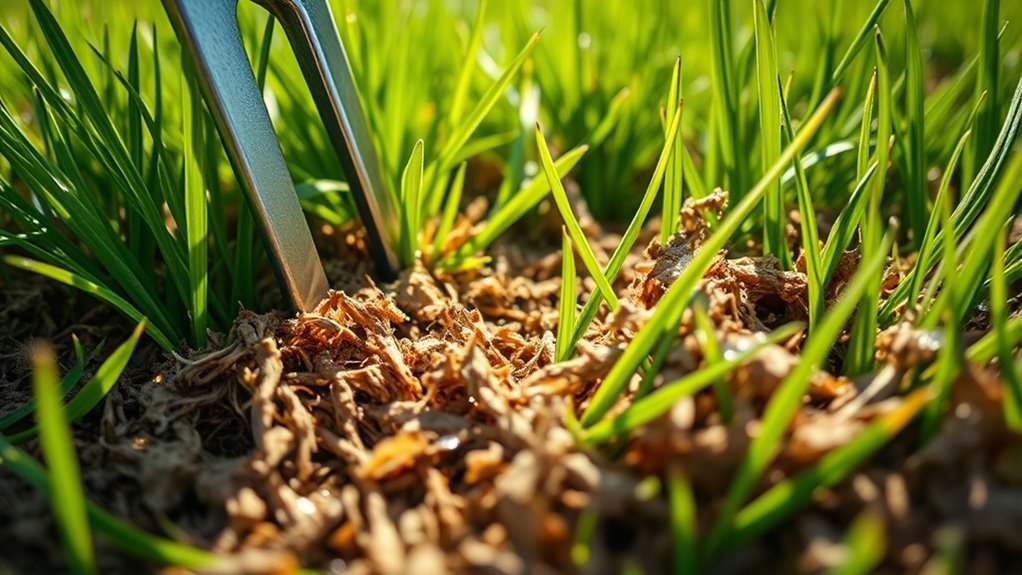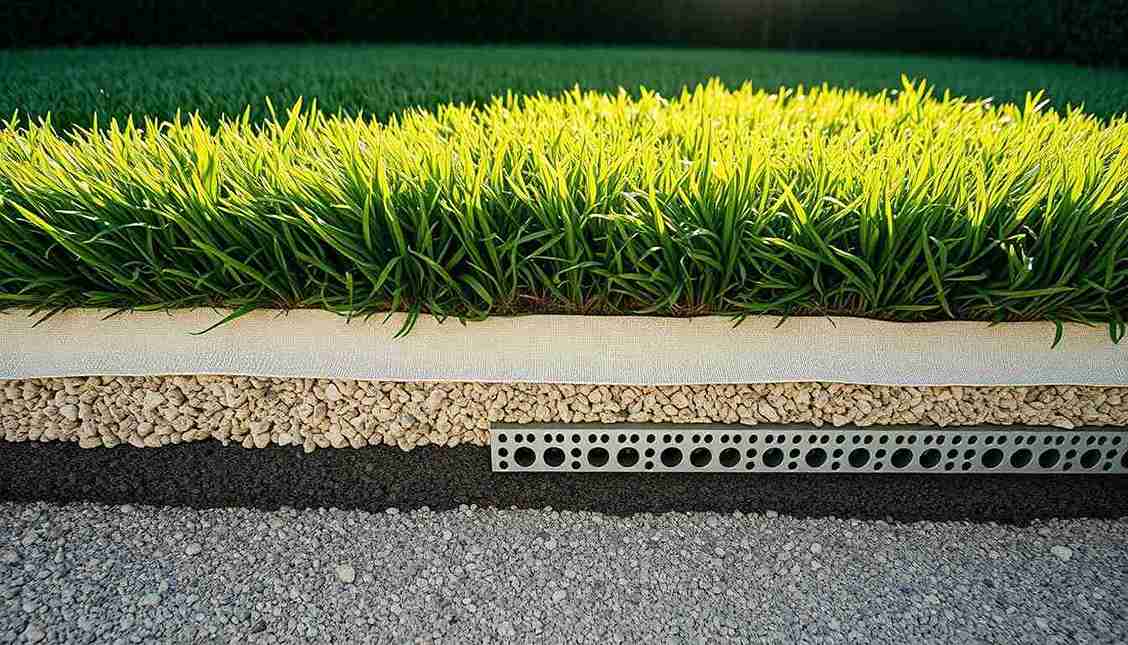You’ll need to water your lawn 2-3 times per week during peak summer months, providing 1-2 inches of total weekly water. Schedule irrigation between 4-6 AM for best absorption and reduced evaporation. In winter, decrease frequency to once weekly while maintaining the same total water volume. Smart irrigation systems can automate this schedule and reduce water usage by up to 30% through soil moisture monitoring. Determine how your specific grass type and local climate can refine these baseline recommendations.
Understanding Local Weather Patterns and Their Impact
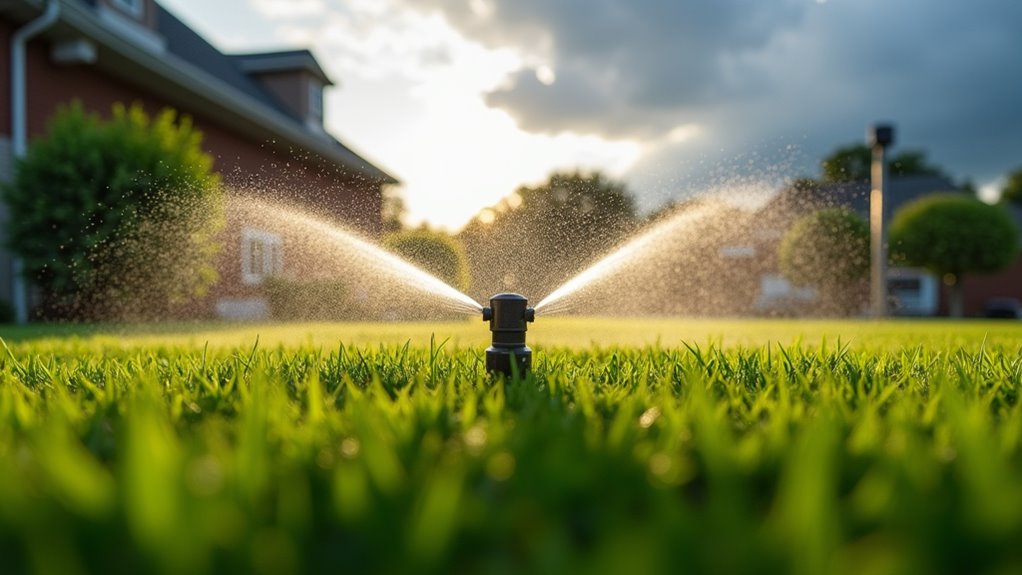
Successfully maintaining a lawn in North Texas requires a thorough understanding of the region’s distinct weather patterns. You’ll need to monitor weather data consistently and adjust your watering schedule based on seasonal variations. During hot, dry summers, your lawn will demand more frequent watering due to high evaporation rates, while winter months allow you to reduce watering frequency.
For conserving water effectively in 2025, you’ll want to factor in your property’s specific microclimate conditions. North Texas experiences unpredictable rainfall patterns year to year, so you should regularly assess local precipitation levels and adjust accordingly. Your lawn’s water requirements will fluctuate with temperature changes, particularly for warm-season grasses during summer months. By staying attuned to these weather patterns, you can optimize your watering strategy while maintaining lawn health.
Best Times of Day for Optimal Watering Results
While achieving ideal lawn health depends on multiple factors, the timing of your watering schedule plays a pivotal role in water conservation and grass robustness.
The best time to water your North Texas lawn is during the pre-dawn hours, just before sunrise. This excellent time of day allows water to penetrate deeply into the soil before intense sunlight triggers rapid evaporation. If you can’t water early morning, schedule irrigation between 4-6 p.m., ensuring grass blades dry before nightfall. Avoid watering during midday when evaporation rates peak.
Monitor your lawn’s appearance to determine the time to water grass effectively. When your turf displays a grayish or dull green color, it’s signaling its need for hydration. While established lawns can survive drought through dormancy, maintaining a consistent early-morning watering schedule increases absorption and promotes healthier root development.
Seasonal Adjustments to Your Watering Schedule
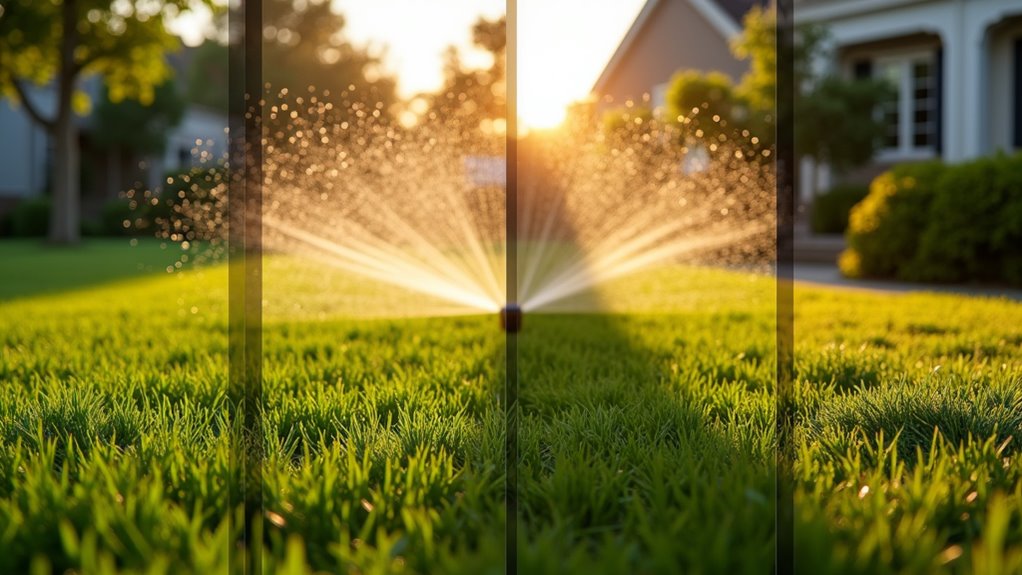
You’ll need to reduce your watering frequency from 3-4 times weekly during summer months to just once per week in winter, while maintaining the ideal 1-2 inches of total weekly water. Your drought response strategy should include real-time monitoring of weather patterns, allowing you to immediately adjust schedules during unexpected rain or dry spells. These seasonal modifications guarantee your lawn receives appropriate hydration as it moves through active growth and dormancy cycles, with spring requiring a gradual increase in frequency while fall demands deeper but less frequent watering sessions.
Summer Vs Winter Patterns
The seasonal demands of lawn maintenance in North Texas require distinct watering patterns between summer and winter months. Your lawn watering schedule needs significant adjustment as temperatures fluctuate throughout the year.
| Season | Factor | Requirement |
|---|---|---|
| Summer | Frequency | 3-4 times weekly |
| Summer | Water Amount | 1-2 inches per week |
| Winter | Frequency | Once weekly |
| Winter | Timing | Morning hours |
| Winter | Water Amount | Less than summer |
During summer vs winter patterns, you’ll need to increase your watering frequency to meet the 1-2 inches of water per week requirement in the hot months. Your irrigation system should be programmed for 3-4 weekly cycles in summer, while winter demands just one morning watering session. Monitor your soil moisture and lawn appearance to fine-tune these baseline frequencies, adjusting for unexpected weather variations that might affect your lawn’s hydration needs.
Drought Response Scheduling
Responding effectively to drought conditions demands a strategic shift in your standard watering schedule. You’ll need to cut your typical water usage by up to 50% while maintaining essential soil moisture. During periods of intense heat of the day, implement a combination of deep watering sessions supplemented by lighter, more frequent sprinklings.
You can optimize your drought response by installing smart irrigation controllers that automatically adjust to real-time weather data. These systems require less water while maximizing efficiency. Don’t rely on fixed schedules – instead, closely monitor weather forecasts and soil conditions to determine when your lawn needs water. Consider shifting to drought-tolerant grass varieties that don’t need as much water to thrive. This adaptive approach guarantees your lawn remains healthy while conserving precious water resources during dry spells.
Smart Irrigation Technology and Water Management
Modern smart irrigation systems have revolutionized lawn watering through precise, data-driven automation. Your smart irrigation system integrates real-time weather data and lawn-specific characteristics to ideal watering schedules, while soil moisture sensors monitor ground conditions to trigger irrigation only when necessary, cutting water usage by up to 30%.
You’ll benefit from advanced sprinkler systems featuring pressure-regulated heads and matched precipitation rates, ensuring uniform coverage across your lawn. High-efficiency nozzles minimize water waste by producing suitably-sized droplets that resist evaporation and prevent runoff. You can manage your entire irrigation setup through smartphone apps, making real-time adjustments based on changing weather patterns. This technology-driven approach delivers exactly what your lawn needs, when it needs it, eliminating guesswork and maximizing water conservation.
Signs Your Lawn Needs More or Less Water
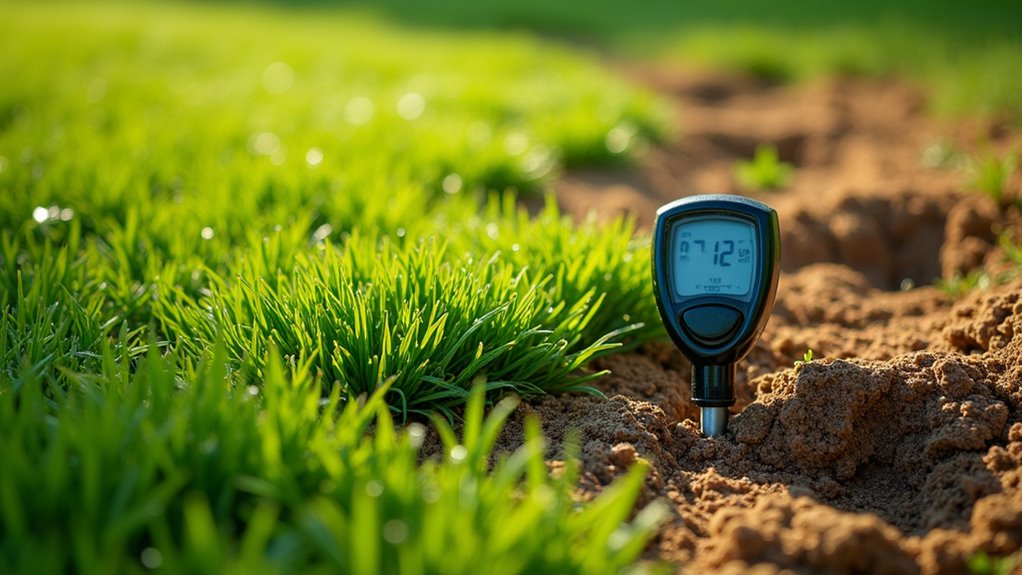
Reading your lawn’s signals helps you make precise watering decisions based on observable indicators. You’ll know it’s time to adjust the amount of water when you notice specific visual and physical changes in your grass.
Monitor for a grayish or dull green color, which indicates a need to water. If your footprints remain visible after walking across the lawn, you’ll need to increase moisture levels. Test soil penetration by attempting to insert a tool 6 inches deep – resistance suggests proper watering hasn’t occurred.
Don’t panic if you can’t water immediately. Well-maintained lawns can enter dormancy and survive several weeks without irrigation. Conversely, if you’re seeing puddles or soggy areas, you’re overwatering. Adjust your watering schedule accordingly to maintain ideal soil moisture without saturation.
Different Grass Types and Their Water Requirements
Your cool-season grasses, such as tall fescue, demand 1-1.5 inches of water weekly to maintain ideal health and growth. In contrast, warm-season varieties like bermuda and zoysia are more efficient, requiring only 0.5-1 inch of weekly watering. St. Augustine grass, another warm-season option well-suited for humid regions, needs a moderate 0.75-1 inch of water per week to flourish.
Cool-Season Grass Guidelines
While maintaining a lush, green lawn requires careful attention to watering schedules, cool-season grasses demand specific irrigation protocols to thrive. To properly water your lawn, you’ll need to provide 1-2 inches weekly during peak growing seasons. Your irrigation system should deliver this water in the early morning, deeply soaking the soil to 6-8 inches.
You’ll notice cool-season grass may struggle during drought periods, turning brown without adequate moisture. However, don’t overcompensate by overwatering, as this can trigger disease and weed growth. Instead, monitor soil moisture carefully and adjust your schedule based on conditions. During winter months, you can reduce watering substantially – a single deep soak weekly will suffice to prevent desiccation. Remember to check soil moisture regularly and adapt your irrigation approach accordingly.
Warm-Season Watering Needs
Several warm-season grass varieties thrive in North Texas, each with distinct water requirements for ideal growth. To take the guesswork out of how often to water your lawn, follow these specific guidelines based on grass type:
- Bermuda grass needs 1-1.5 inches per week to maintain its appearance and health
- Zoysia grass performs well with 0.75-1 inch per week when properly maintained
- St. Augustine grass requires 1-1.5 inches per week to stay lush and vibrant
- Buffalograss, the most drought-tolerant option, thrives with just 0.5-1 inch per week
These measurements guarantee ideal growth during the growing season. Your irrigation system’s effectiveness plays a pivotal role in meeting these requirements. Regular system maintenance and appropriate scheduling help deliver the right amount of water to your specific grass type, maximizing lawn health while conserving resources.
Soil Composition and Water Retention Factors
Understanding soil composition serves as the foundation for efficient lawn watering practices in 2025. Your soil’s clay content directly impacts its water-holding capacity, with higher clay percentages requiring less frequent irrigation. To optimize water retention, you’ll need to assess your soil’s organic matter content, as it plays a vital role in moisture management.
You’ll find that compacted soil creates watering challenges, forcing water to run off rather than penetrate deeply. If you’re dealing with compaction, you’ll need to water more frequently but with less volume to prevent wastage. The depth of your topsoil is just as important – deeper topsoil stores more water, allowing you to extend intervals between watering sessions. By analyzing these soil composition factors, you can create a precise watering schedule that enhances efficiency while maintaining lawn health.
Water Conservation Strategies for Sustainable Lawns
Building on your soil composition knowledge, modern water conservation methods revolutionize lawn maintenance in 2025. To keep your lawn healthy while ensuring no water is wasted, automated systems like WaterMyYard deliver precise, weather-based recommendations. Research shows over 50% of the environment is typically wasted through conventional methods, making data-driven irrigation essential.
To make sure you’re maximizing water efficiency:
- Monitor local weather patterns and adjust watering schedules based on predicted rainfall
- Follow automated weekly recommendations that account for exact soil moisture needs
- Implement timing-based irrigation to prevent water loss through evaporation
- Maintain proper soil health, as healthy lawns naturally require less water
These evidence-based strategies help you maintain a vibrant lawn while conserving crucial water resources, transforming traditional irrigation practices into sustainable solutions for 2025 and beyond.
Professional Maintenance and System Optimization
Professional expertise transforms your lawn irrigation system from a basic sprinkler setup into a precision-engineered operation that optimizes water efficiency while minimizing waste.
When you’re watering your lawn, timing and precision matter greatly. Professional lawn care services conduct three pivotal assessments throughout the year. They’ll analyze your sprinkler system in early spring to optimize performance before peak growing season, adjust watering schedules during summer drought periods, and perform essential winterization in late fall to prevent system damage.
You’ll benefit from site-specific solutions that account for your lawn’s unique characteristics and local climate patterns. By partnering with professionals, you’ll eliminate the uncertainty of irrigation management. They’ll maintain your system’s components, calibrate water distribution, and implement data-driven adjustments that certify your lawn receives exactly what it needs, when it needs it.
Frequently Asked Questions
How Often Does the Lawn Actually Need Watering?
You’ll need to water your lawn based on soil moisture levels and local climate factors. During the growing season, apply 1-2 inches of water 3-4 times weekly. However, you shouldn’t follow a rigid schedule – instead, implement water conservation strategies by monitoring your lawn’s specific needs. In winter, reduce watering to once weekly. Always check soil moisture before watering and adjust your schedule according to rainfall, temperature, and grass type.
What Is the 1/2/3/2:1 Lawn Watering Technique?
The 1/2/3/2:1 technique is a precise watering method that you’ll implement in cycles. You’ll water for 1 minute, pause for 2 minutes, water for 3 minutes, pause again for 2 minutes, and repeat. This approach optimizes consistent soil composition and promotes proper drainage systems by allowing water to penetrate deeply. It’s particularly effective when you’re adapting to seasonal precipitation patterns, as it prevents runoff and encourages stronger root development through controlled saturation intervals.
How Many Minutes Should I Run My Sprinklers?
For ideal soil moisture levels, you’ll need to run rotor sprinkler heads for 25-35 minutes and spray heads for 10-15 minutes per zone. To enhance sprinkler system efficiency, you should test water penetration by checking if moisture reaches 6-8 inches deep. Consider using water conservation methods like moisture sensors to fine-tune your timing. You’ll need to adjust these durations based on your specific lawn conditions and local climate to prevent overwatering or underwatering.
Is 10 Minutes of Watering the Lawn Enough?
No, 10 minutes isn’t enough to achieve ideal moisture levels for your lawn. You’ll need 25-35 minutes for rotor heads or 10-15 minutes for spray heads per zone to deliver the required 1-2 inches of weekly water. To optimize your water efficiency strategies, you’ll want to measure your sprinkler performance metrics using catch cups. Short watering durations can actually harm your lawn by promoting shallow root systems, making your grass less drought-resistant.


